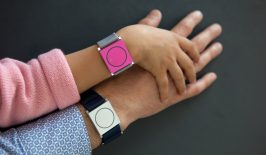A smart paint could soon be helping blind people navigate cities by sending vibrations to their canes at street crossings.
It can be hard to make your way across the street in a busy city – constantly dodging cars, bikes and other pedestrians. What about for those who are visually-impaired?
A new technology is making easier to blind people to cross the streets by making canes vibrate when they bring it into contact with the painted lines of the crossing. The Ohio State School for the Blind has partnered with private companies and the city of Columbus to test this smart paint at its campus.
The technology features two key elements. The first one is the paint which is applied to the road surface. It’s been developed by Intelligent Material Solutions, a company that is working on products that, using rare-earth nanocrystals, can emit a unique light signature . The second element is a sensor that’s added to the tip of the cane, which can activate and read the paint’s light signature, meaning that when a visual impaired person touches it with their cane, it sends a vibration back.
Currently, visually impaired people tend to rely on the sound of the traffic or the beeping of traffic lights when crossing a road, but this becomes a problem at streets with low traffic or when the traffic lights make no sound. “Modern urban intersections are becoming increasingly complex. That means that finding a crosswalk, aligning to cross and maintaining a consistent crossing direction while in motion can be challenging for people who are visually impaired,” explains John Lannuti, professor of materials science engineering at Ohio State University to govtech.
The people behind the project assert that the technology is a cost-effective one, with no expensive infrastructure required – a layer of this “smart” paint simply having to be added to existing road markings. Because the rare earth taggants they add to the paint have such unique optical properties, it’s very easy to detect, meaning very little has to be added and the price of paint doesn’t increase significantly.
What Else Could it Be Used For?
As well as being used to paint road markings, this smart paint can appear clear or grey on grey surfaces, making it practically invisible to sighted people. That means that it could also be used in other places too, as a new way of providing the visually impaired with guidance around cities. “We’re also thinking about providing them with guidance as they move down a sidewalk or guidance about whether or not they’ve arrived at a bus stop or at a certain destination,” John Lannuti told FastCompany. Further innovation could use the paint into a sort of GPS or GoogleMaps for the blind, where a person’s phone is connected to the paint and sets a path for them, telling them when they’ve arrived at their destination.
The smart cane could also be used to communicate with other road users, such as with vehicles, to notify them the presence of an visual impaired person crossing the road, or to warn the cane user in advance if the road is blocked or a car is passing by too close.
In fact, Industrial Material Solutions weren’t originally developing the paint to help visually impaired people. Instead they were testing it to find out its potentials for autonomous vehicles – seeing whether it could help cars to recognise intersections, change lanes, or help to add markers to roads to make GPS more accurate.
Check out our archive of articles on Smart Cities to learn more about how tech could revolutionise the urban environments of the future.





